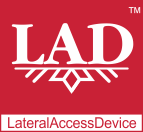
LateralAccessDevice
takes you back to before the Internet
How It Works | Download LAD | Support | LAD Security | Features & Uses | Resources | Members | User Guide
How to Capture Packets with LADCapturing packets with LAD is as simple as connecting a few cables (really!). By default LAD automatically captures data on every port, meaning you can capture all traffic that passes through it in aggregate and also just the traffic pertaining to specific devices, whether they are connected directly to one of LAD's ports, via a switch or wirelessly via a Wi-Fi card. In some circumstances LAD may not be able to differentiate between the traffic of individual devices, for example, if they are connected to LAD via a router that obscures their identifying information (such as when using NAT). The Virtues of Long-Term Packet CaptureLong-term, or continuous, packet capture offers several advantages over "spot checks." The first and most obviously is that you have the data at all times, whether or not you need it for a specific purpose. Continuously capturing packets with LAD is an easy, no-hassle task. If LAD is connected, by default it is capturing the packets. LAD also has no issue with storage or storage management because it captures and stores the packets in a circular fashion, in which the newest data overwrites the oldest once it reaches capacity. If you need a longer lookback period before things get overwritten, simply switch out the HDD of the chassis on which you are running LAD for a bigger one. In pass-through operation LAD's packet capture function operates passively and does not interfere with the traffic, which is the hallmark of commercial-grade packet capture. Much like a video camera, it simply records what passes through, without altering it. In addition to pass-through capture, LAD can accept packet data from a router or switch's SPAN/mirror ports. SPAN/Mirror CaptureTo convert LAD into a dedicated, standalone appliance for commercial-grade full packet capture off a SPAN or mirror port takes just a few simple steps:
After LAD reboots, the port will not route traffic, but instead capture and record everything that it receives. Pass-Through CaptureFor pass-through (aka inline) capture, you will need to change the settings on two of LAD's ports. For illustrative purposes, here are the sequence of steps to set up ports 3 and 4 for pass-through.
After LAD reboots, the two ports will simply pass the traffic through from one side to the other, as if there were no intervening equipment between the devices and equipment attached to either port. Sample Configurations for Professional UsersThe minimum recommended hardware configuration when using LAD for packet capture is three network interfaces, however, four or more would be preferred for most circumstances. LAD with multiple network interfaces offers several capabilities that prove quite handy for professional users, from software and web developers to network engineers and network support teams.
Wi-Fi Packet CaptureLAD's robust Wi-Fi features include wireless packet capture for the 2.4Ghz, 5Ghz and 6Ghz bands. In addition to capturing the Wi-Fi traffic between LAD and its clients, LAD may also be set up for dedicated Wi-Fi packet capture on any channel on any of the three bands, in which case it will capture all of the wireless activity it detects, regardless of source. This capability is particularly helpful in detecting over-congested Wi-Fi channels, helping make the heavily utilized 2.4Ghz band usable again. |